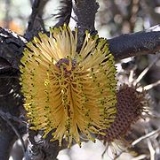
Banksia candolleana
Encyclopedia
The Propeller Banksia (Banksia candolleana) is a species of shrub in the plant
genus
Banksia
. It occurs in sandplain country north of Gingin, Western Australia
.
0.5–1.3 m (20–50 in) high and 2.5 m (8 ft) wide, Banksia candolleana has linear leaves 15–40 cm (6–16 in) long and 0.6-2 cm wide. The leaves are green and shiny with deep trangular lobed margins. Appearing from April to July (autumn to winter), the squat inflorescences arise on short lateral branchlets and are golden yellow in colour. Ovoid in shape, they are 5.5–7.5 cm wide. As the flower spikes age, they turn to grey and 1–5 large follicles develop.
in 1855, after being collected by James Drummond
. Its species name honours Meissner's countryman Augustin Pyramus de Candolle.
on sandplains north of Perth. The annual rainfall is 600–700 mm.
after bushfire. Some large shrubs have been estimated at 1,000 years old.
Ants and bees, including the European Honeybee, have been recorded visiting flower spikes.
s, but does not do well in climates of higher humidity on the east coast of Australia. Seeds do not require any treatment, and take 22 to 35 days to germinate.
Plant
Plants are living organisms belonging to the kingdom Plantae. Precise definitions of the kingdom vary, but as the term is used here, plants include familiar organisms such as trees, flowers, herbs, bushes, grasses, vines, ferns, mosses, and green algae. The group is also called green plants or...
genus
Genus
In biology, a genus is a low-level taxonomic rank used in the biological classification of living and fossil organisms, which is an example of definition by genus and differentia...
Banksia
Banksia
Banksia is a genus of around 170 species in the plant family Proteaceae. These Australian wildflowers and popular garden plants are easily recognised by their characteristic flower spikes and fruiting "cones" and heads. When it comes to size, banksias range from prostrate woody shrubs to trees up...
. It occurs in sandplain country north of Gingin, Western Australia
Gingin, Western Australia
Gingin is an agricultural town in Western Australia. The town is located north of Perth along the Brand Highway.The town is well suited for agriculture with a mild climate and available water sources...
.
Description
Encountered as a many-branched spreading shrubShrub
A shrub or bush is distinguished from a tree by its multiple stems and shorter height, usually under 5–6 m tall. A large number of plants may become either shrubs or trees, depending on the growing conditions they experience...
0.5–1.3 m (20–50 in) high and 2.5 m (8 ft) wide, Banksia candolleana has linear leaves 15–40 cm (6–16 in) long and 0.6-2 cm wide. The leaves are green and shiny with deep trangular lobed margins. Appearing from April to July (autumn to winter), the squat inflorescences arise on short lateral branchlets and are golden yellow in colour. Ovoid in shape, they are 5.5–7.5 cm wide. As the flower spikes age, they turn to grey and 1–5 large follicles develop.
Taxonomy
Banksia candolleana was first described by Swiss botanist Carl MeissnerCarl Meissner
Carl Daniel Friedrich Meissner was a Swiss botanist.Born in Bern, Switzerland on 1 November 1800, he was christened Meisner but later changed the spelling of his name to Meissner. For most of his 40 year career he was Professor of Botany at University of Basel...
in 1855, after being collected by James Drummond
James Drummond (botanist)
James Drummond was a botanist and naturalist who was an early settler in Western Australia.-Early life:...
. Its species name honours Meissner's countryman Augustin Pyramus de Candolle.
Distribution and habitat
Banksia candolleana is found from Arrowsmith south to GinginGingin, Western Australia
Gingin is an agricultural town in Western Australia. The town is located north of Perth along the Brand Highway.The town is well suited for agriculture with a mild climate and available water sources...
on sandplains north of Perth. The annual rainfall is 600–700 mm.
Ecology
Banksia candolleana regenerates from a woody lignotuberLignotuber
A lignotuber is a starchy swelling of the root crown possessed by some plants as a protection against destruction of the plant stem by fire. The crown contains buds from which new stems may sprout, and a sufficient store of nutrients to support a period of growth in the absence of...
after bushfire. Some large shrubs have been estimated at 1,000 years old.
Ants and bees, including the European Honeybee, have been recorded visiting flower spikes.
Cultivation
Banksia candolleana is slow growing in cultivation and may take up to 10 years to flower from seed. It grows readily in well-drained soils in Mediterranean climateMediterranean climate
A Mediterranean climate is the climate typical of most of the lands in the Mediterranean Basin, and is a particular variety of subtropical climate...
s, but does not do well in climates of higher humidity on the east coast of Australia. Seeds do not require any treatment, and take 22 to 35 days to germinate.

